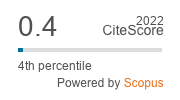Histological and histochemical studies on the male accessory glands of culicine mosquitoes
DOI:
https://doi.org/10.33307/entomon.v1i2.1132Abstract
The paper deals with studies on the development, histology and histochemistry of the male accessory glands of Aedes aegyptii and Culex pipiens fatigans. The paired accessory glands in both the species grow rapidly from pupal stage till they mature in two-day old adults. The glands have an outer layer of muscles and an inner layer of simple columnar secretory cells. In Culex the gland has a central lumen in pupal stage while it is partly filled with cells in Aedes. The secretory cells are similar morphologically hut secretory activity is more in the posterior part of the glands than in the anterior part in both the species. The secretory granules in Aedes are small and are present in the lumen of the gland within polygonal cells whereas in Culex they are large and are not in bound form. Histochemical. Study suggests that the secretion is predominantly proteins, rich in SH-containing aminoacids. Further histochemical evidences indicate the presence of glycogen in the secretions of Aedes and Culex, and mucopolysaccharide in Culex only. The relevance of these findings is discussed.
Downloads
Published
How to Cite
Issue
Section
License
Copyright (c) 2024 Association for Advancement of Entomology

This work is licensed under a Creative Commons Attribution-ShareAlike 4.0 International License.


